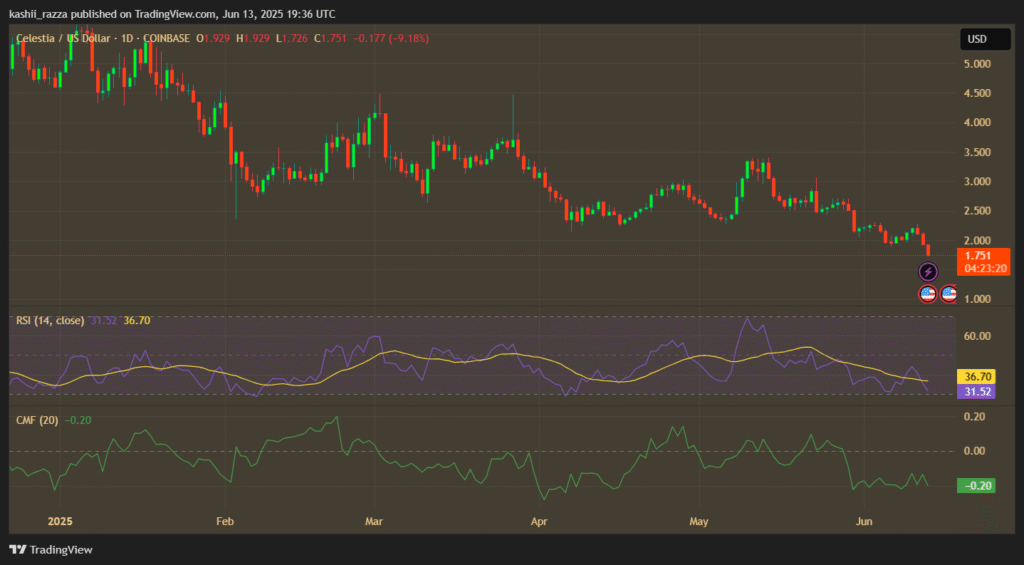Celestia, introduced as a fresh attempt to change how blockchain networks scale, has not lived up to its early expectations. Built to serve as a data availability layer for other blockchains, the project attracted early attention for its modular design.
The network went live in October 2023, and within months, its token TIA surged to nearly $21 in early February 2024. By mid-2025, however, that momentum had vanished. TIA is now down more than 91% from its peak. This decline isn’t isolated but the result of multiple pressures, both internal and external, that have kept the project from gaining long-term traction.
Table of Contents
What is Celestia?
Celestia is based on the idea that blockchain layers can be separated to improve scalability. Instead of handling execution, consensus, and data all in one place, it focuses solely on data availability. The architecture was first proposed by Mustafa Al-Bassam in a 2019 research paper called LazyLedger. He was later joined by Ismail Khoffi and John Adler to turn the paper into a functioning network.
The network runs on proof-of-stake and uses its native token, TIA, for gas fees, staking, and payments related to data use. The total supply of TIA is capped at 1.12 billion, and the project was launched with a $300 million token distribution. This set the stage for what many thought would be a promising infrastructure layer for other chains and rollups.
Technically, Celestia’s key innovation lies in how it helps “light nodes” check data availability without downloading full blocks. It achieves this through a combination of erasure coding and data availability sampling. These systems aim to help less powerful nodes confirm that block data hasn’t been withheld, offering a lightweight but secure way to interact with the chain.
Token Launch and Initial Hype
After the October 2023 launch, early trading showed strong enthusiasm. The modular model, backed by credible developers, drew quick comparisons to other infrastructure solutions in the blockchain world. That optimism drove TIA’s price to nearly $21 by early February 2024.
The concept of separating data handling from execution received support, particularly in light of scaling issues faced by larger networks like Ethereum. Many developers and analysts expected that Celestia could become a default data layer for Layer 2 chains and rollups. But after the initial spike, cracks in the framework started to show.
The rise in price proved short-lived. TIA could not maintain momentum as it became clear that actual adoption and use-case expansion was slower than anticipated. Despite technical soundness, the absence of widespread integration limited growth potential.
TIA Road to 91% Crash
The sharpest blow came in October 2024 when a major portion of locked TIA tokens were released into circulation. These included large allocations reserved for early investors and team members. The sudden increase in available supply nearly doubled the number of tokens in the market, causing a flood of selling.
Throughout the first half of 2025, TIA has remained unable to break above key resistance levels. For three consecutive months, the price hovered around $2.50 before sliding further. Indicators such as the Relative Strength Index (RSI) and Chaikin Money Flow have both pointed to lackluster buying interest.

Now TIA price has broken below support and retested it, confirming a bearish structure. A downtrend line now acts as resistance. New positions will be considered only if the price breaks above the downtrend line. The key resistance area remains between $2.05 and $2.08.
A death cross pattern formed in late 2024 only reinforced this view. The crossover of short-term moving averages below longer-term ones typically signals a negative outlook, and TIA followed that pattern closely. These signs pushed many traders to exit their positions, further lowering liquidity and stability.
At the time of writing, the TIA price fall of over 91% since February 2024 is not just a product of poor timing – it’s a sign of missing traction. Unless both usage and adoption metrics improve, there’s little reason to expect a meaningful turnaround in the short term.
No Bull Run in Sight to Save TIA
The general condition of the crypto market has not helped Celestia. While Bitcoin holds well, major altcoins like Ethereum and Solana are struggling to hold momentum during 2025. This makes it harder for lesser-known tokens like TIA to attract new capital. There’s been no strong bull market wave to carry altcoins along.
The problem isn’t just market direction but competition as well. Other modular and Layer 2 projects are appearing with similar features. In some cases, these competitors offer simpler integration paths or better financial incentives for developers. As such, Celestia’s early technical edge may no longer be enough.
On-chain activity for TIA reflects this hesitation. Low trading volume and lack of large wallet accumulation show that most investors are either holding passively or staying away. Without a clear trigger for change, confidence remains weak.




